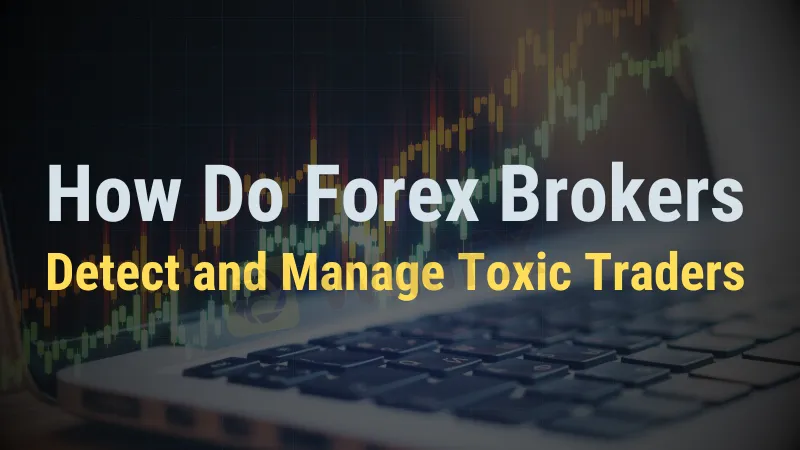简体中文
繁體中文
English
Pусский
日本語
ภาษาไทย
Tiếng Việt
Bahasa Indonesia
Español
हिन्दी
Filippiiniläinen
Français
Deutsch
Português
Türkçe
한국어
العربية
How Do Forex Brokers Detect and Manage Toxic Traders
Abstract:Discover how advanced analytics empower forex brokers to effectively identify and manage toxic traders, ensuring operational stability and profitability.

Introduction
In the fast-paced world of forex trading, brokers face a significant challenge – the identification and management of high-risk trading behaviors that can disrupt their operations and profitability. These traders, often referred to as “toxic” traders, employ various strategies, such as scalping, arbitrage, and news trading, which can undermine the stability of brokerage operations, especially during periods of market volatility. In this article, we will explore the importance of identifying and managing toxic traders and how advanced analytics platforms are revolutionizing risk management for brokers.
The Challenge of Detecting 'Toxic' Traders
Traditional methods of monitoring trading behaviors struggle to keep pace with the immense volume of data generated in today's electronic trading markets. Brokers process millions of price updates and trades daily, making it nearly impossible to manually identify high-risk behaviors. Toxic traders employing strategies like scalping and arbitrage pose a significant threat to brokers, as their activities can erode profit margins and destabilize the brokerage's overall operations.

Detecting Toxic Trading Behaviors
Toxic trading behaviors can take various forms, and brokers need to know what to look for. Some common toxic trading behaviors include:
Scalping: Toxic traders engage in rapid and frequent trading to profit from small price movements. By analyzing trade frequency, speed, and profitability, brokers can identify scalping activities among the vast number of daily trades.
Arbitrage: Toxic traders may exploit price differences between different markets or trading venues to gain an unfair advantage. Advanced analytics can help detect and flag such activities.
News Trading: Toxic traders exploit market volatility following news events by sending multiple or larger-than-typical trades, not allowing brokerages enough time to cover themselves before the market moves against them.

Tackling Toxic Trading with Advanced Analytics
Advanced analytics platforms offer brokers a powerful solution to tackle toxic trading behaviors effectively. These platforms provide several key features to enhance risk management:
Comprehensive Trader Profiling: Advanced analytics create detailed profiles for each trader, enabling the identification of various high-risk strategies. The platform assigns a 'toxicity' score to traders, providing brokers with an early warning system for potential risks.
Real-time Alerts: Brokers receive real-time alerts tied to specific risk thresholds, enabling proactive risk management. These alerts allow brokers to respond swiftly to emerging threats and potential disruptions.
Powerful Analytics: The platform can process extensive trade data, providing insights into current client exposures, trading activities during market volatility, and attempts to manipulate the system. This information empowers brokers to make informed decisions regarding risk management.
Interactive Dashboards: User-friendly dashboards allow brokers to filter and access relevant data quickly. This feature transforms raw information into actionable intelligence, facilitating effective decision-making.
Safeguarding Brokerage Operations
In the constantly evolving landscape of trading strategies and market conditions, advanced analytics platforms equip brokers with the essential tools needed to stay ahead. By converting raw tick data into targeted alerts and risk profiles, brokers can dynamically manage client risks, restrict detrimental activities, and safeguard their operations against market volatility.
Conclusion
In the high-stakes world of forex trading, brokers must remain vigilant in identifying and managing toxic traders to protect their profitability and operational stability. Advanced analytics platforms offer a cutting-edge solution to this challenge, with their real-time risk monitoring capabilities and advanced analytics. Brokers seeking to enhance their risk management strategies and protect their operations should consider leveraging the power of advanced analytics. By doing so, they can effectively detect and manage high-risk trading behaviors, ensuring a more secure and prosperous trading environment for both brokers and their clients.

Disclaimer:
The views in this article only represent the author's personal views, and do not constitute investment advice on this platform. This platform does not guarantee the accuracy, completeness and timeliness of the information in the article, and will not be liable for any loss caused by the use of or reliance on the information in the article.
Read more

CMC Markets: A Closer Look at Its Trading Environment
CMC Markets provides access to four trading platforms: MetaTrader 4 (MT4), MetaTrader 5 (MT5), TradingView, and its proprietary web platform. Each platform supports different tools, asset classes, and execution features.

He Lost RM275,000 to a Fraudulent "Moomoo" Scam
A 57-year-old engineer lost RM275000 in an online investment scam that misused the name of a well-known trading platform, Moomoo. The scam was promoted through a Facebook advertisement in April and led the victim to believe he was engaging in a credible investment opportunity.

The Hidden Dangers of Viral Trading Advice
Do you turn to social media for trading advice? If yes, do you know that much of what you are consuming could be doing more harm than good?

Forex Trading Lot Size: Decide it Right to Reap the Right Results
Determining the right forex trading lot size is pivotal to enjoying a long run in the forex market. Go through this guide to know how to do it.
WikiFX Broker
Latest News
The Dollar Keeps Falling: How Should We View Exchange Rate Volatility?
Asia-Pacific markets mostly rise as investors parse a slew of data releases
Asia-Pacific markets rise as investors parse a slew of data releases
WikiFX Gala Night Malaysia Concludes Successfully
IG Group Unlocks Over £425 Million amid a Capital Reduction
Gold Prices Fall by INR 39,300 in the Last Week? What's Next Week's Outlook?
European stocks open slightly higher as UK-U.S. trade deal cuts autos, aviation tariffs
Treasury yields tick lower as Trump's spending bill in focus
European stocks mixed as UK-U.S. trade deal cuts autos, aviation tariffs
Ripple and SEC Drop Appeals, Bringing 5-Year Legal Saga to a Close
Currency Calculator


